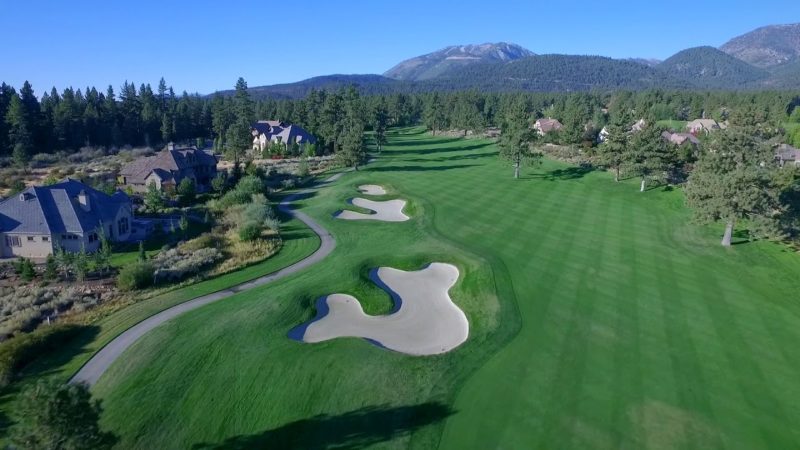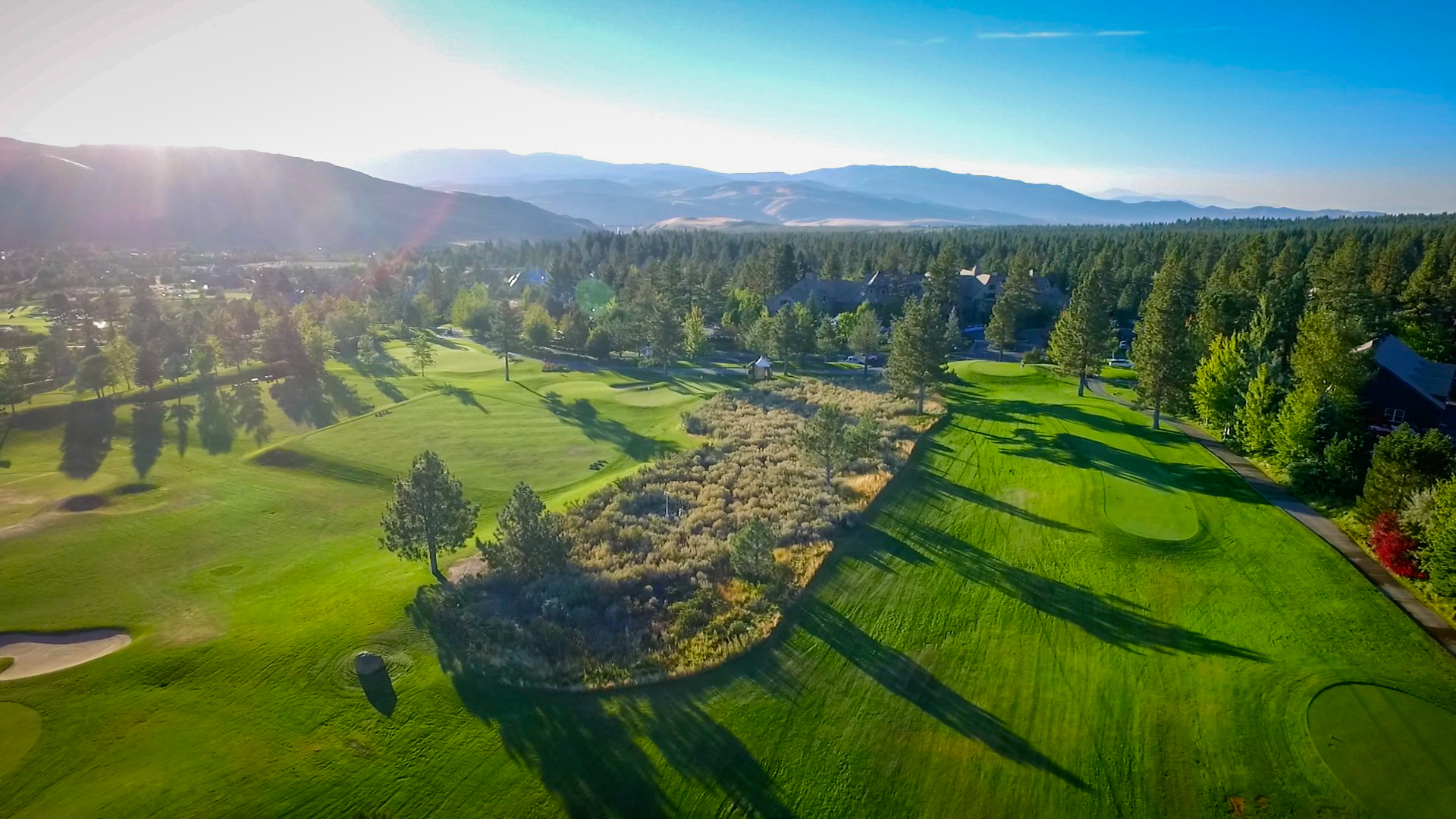Host of PGA Tour’s Barracuda Championship can be a bear; public gem Wolf Run is battered by the winds
RENO, Nevada (July 16, 2021) – Reno’s landmark, lighted downtown arch proclaims it to be “The Biggest Little City in the World.” Anyone visiting the second-largest city in the Silver State should be prepared to embrace the place for all its charms.
The sign was built for a highway exposition in the 1920s but still serves a purpose as Reno offers up the thrills one might see in at other gambling-friendly cities. Yet it still has a bit of a small-town feel and plenty of friendly folks.
If it’s golf that you’re after here at the doorstep of the High Sierras, Reno comes up aces. Set at 4,500 feet above sea level, the area offers a dozen options in the city limits alone, and many more within a 30-minute drive of the downtown sector. The courses vary between facilities difficult enough to host a PGA Tour event, mid-priced daily-fee courses and pleasant municipal venues.
On a recent trip to the region, we played two of the best courses in Reno: the ultra-private and plush Montreux Golf & Country Club (site of the PGA Tour’s Reno-Tahoe Open) and Wolf Run Golf Club, home of the University of Nevada’s men’s and women’s golf teams.
Both courses showcase the best of golf in this area – extreme elevation changes in the foothills of the Sierra Nevadas, and an alpine feel. But, really, the comparisons end there.

Montreux is Like a Day of Golf in Switzerland
Montreux Golf & Country Club, named after the Swiss city on the eastern banks of Lake Geneva, revels in its mountainous personality. Opened in 1998, the Jack Nicklaus Signature Course weaves and heaves through both open high-desert areas and towering pines, playing to a par of 72 and as long as 7,472 yards from its back set of six tees.
The course, which is usually buffeted by strong winds off the mountains, carries a rating of 75.3 and a 141 Slope but plays much tougher because of its rolling fairways and punitive rough.
At an elevation at 5,500 feet (about a thousand feet higher than Reno’s airport), Montreux has three par-4s of 464 yards or more and its pair of three-shotters are over 600 yards and plenty hearty.
While the course is the centerpiece of an upscale residential community, homes are well off the fairways and rarely seen through the pines. The fairways and tees are Pro-Cup bentgrass, the putting surfaces Crenshaw bentgrass, and the roughs a fescue-bluegrass blend. In addition to seven holes involving small lakes, more than 70 bunkers serve as hazards on the course.

Montreux begins with a pair of monster par-4s – the 494-yard first and 491-yard fifth – in its first five offerings, but its “Bear Trap” at Nos. 6 (a 477-par-4), 7 (a par-3 over water at 183 yards) and the massive (636-yard) par-5 eighth comprise the most challenging stretch on the front half.
The course’s final trio is among the most talked-about holes on the PGA Tour each year, a set where there can easily be a three- to five-stroke swing that can change the outcome of the Barracuda Championship, or any match for that matter.
The 220-yard par-3 16th moves downhill to a narrow two-tiered green that slopes away from the tee on the back half, causing any shot that carries past the middle to roll off into thick rough. The 464-yard par-4 17th starts at an elevated tee that heads off to a narrow fairway 138 feet below. The green here is narrow and sloping, with a creek snaking between around the back.
The closer is a par-5 of 616 yards, but it actually plays much shorter because of the altitude, a considerable elevation drop and a fairway slope that propels the ball forward. The green is protected at the right by a waterfall-adorned pond and by bunkers short-right and long-right. This great risk-reward hole can yield anything from an eagle to a double-bogey.
Golf Digest voted Montreux among its “10 Best New Private Courses” for 1998 and it’s only gotten better, and more difficult, as it has matured. It’s the cream of the crop among courses in Reno proper. Just make sure you play the correct tees to have an enjoyable round.
Wolf Run GC offers subtle challenge with plenty of spice
Just three miles as the crow flies and 900 feet down the mountain from Montreux is Wolf Run Golf Club. Set on mostly open terrain, target golf is the byword at this John Fleming-designed, 7,100-yard layout.

Fleming, the golf course superintendent at The Olympic Club in San Francisco for 30 years before semi-retiring in the Carson Valley, fashioned a course with a good balance of risk-reward two-shotters, long par-3s that demand finesse, and mid-range par-5s. The par-72 venue has enough bite to carry a recently raised rating of 73.1 and Slope of 133 from the tips.
Opened in 1998, Wolf Run sees more than half its holes start with heightened tees. The course rises and falls like waves on the ocean, some with elevation changes of up to 100 feet.
Built on land donated to the University of Nevada as the home of the Wolfpack’s golf teams, Wolf Run is challenging but not too punitive, and fair but not easy. Its last line of defense is the putting surfaces, which can be especially testy if the wind is howling off the mountains to the west.
The first real challenge is the fourth, a 420-yard par-4 played from elevated tees with a creek splitting the fairway. An aggressive and accurate drive can lead to a very short approach. At 451 yards, the ninth, the longest two-shotter at Wolf Run, has a split fairway that forces golfers to choose sides. The hole is best played from the left for the easiest approach to a green that slopes left to right and is protected on the starboard side by a severe drop-off and bunker.

The toughest hole at Wolf Run is the downhill, dogleg-left, 450-yard par-4 12th, which tempts players to cut the corner in search of the fastest route to the green. It’s tougher (and farther) than it looks to play over the corner, but it will provide a chance to attack a putting surface guarded by a creek and two bunkers.
Hitch up your pants for the three-hole stretch at Nos. 14, 15 and 16. First the 14th, a par-3 at 218 yards, ends at a green in a bowl pinched by a front bunker and a creek. Tee shots landing right of the target will feed to the left as the green slopes towards the front-left.
The 15th is a 546-yard par-5 that doglegs left around a creek that eventually crosses before the green. With all the danger off the tee along the left, the ideal drive is aimed just to the left of the fairway bunker along the right. The putting surface is split in two by a back bunker, and tilts both to the front-right and front-left.
At 438 yards and slightly downhill to right, the par-4 16th tempts golfers to try to blast the ball off the tee toward the green. But there’s a bunker at the right of the prime landing area, and the approach must find a safe haven on a bunker-ringed green.
Wolf Run concludes with a reachable-in-two, 527-yard par-5. Drives should be played to the right side of the fairway, where less than a 170-yard approach will stop short of the creek dividing the fairway.
Wolf Run offers an entertaining round in the Reno/Sparks area. While the layout is straightforward, Fleming added some spice with these elevated, sloping greens. The challenge is more subtle than dramatic, and golfers appreciate this fun course the more they play it.











